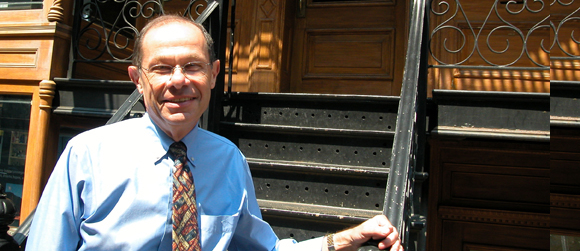Living history
Photograph by Kate Stober
Born in Kazakhstan, where his parents met as Polish refugees, Morris J. Vogel, AM’68, PhD’74, immigrated with his family to Norwich, Connecticut, when he was four: “I became an American historian to understand this society to which I’d been dropped from 30,000 feet.” Studying U.S. social history and identity as an undergraduate at Brandeis, in the U of C history department, and as a professor at Philadelphia’s Temple University, Vogel now works to educate more than 135,000 people every year on the immigrant story as president of New York City’s Lower East Side Tenement Museum.

The call from a search firm to direct the museum—whose founding president, Ruth Abrams, retired June 1 after 20 years—was kismet: “I had followed the invention of this museum and its fortunes,” says Vogel, who spent years researching cultural institutions for his 1991 book, Cultural Connections: Museums and Libraries of Philadelphia and the Delaware Valley (Temple University Press). “It is an iconic institution.” Celebrating its 20th anniversary this year, the museum “operates at capacity,” says Vogel, and one of his challenges “is to meet the demand that’s out there”—hundreds of people are turned away each week because all the tours are full. Another presidential objective: engaging guests in “a national conversation about immigration.” Says Vogel, “We need to have a place where we can help our visitors…understand the broader [immigration] experience, give them the opportunities to discuss contemporary relevance.”—R.E.K.
No armchair historian: [At first] my scholarship tended to be on American history more broadly. As I began doing an engaged social history, as I began working in institutions whose missions were very much focused on marginalized communities, communities trying to negotiate their way in American society, I came to use my background more.
Ruth Abrams’s inspiration: [She understood that] the way to tell the immigrant story was to take one of these tenements in what was [in 1988] a dreary, drug-infested, crime-ridden neighborhood and to just put up a sign saying, “This is a museum,” and this valorizes the experience of the hundreds of thousands of people who poured through these streets as they entered America.
Stories of yesterday… People come to get a story; what they get is an emotional connection to the immigrant experience, and we want to build off the fact that we own the history of immigration to the United States. Yes, it’s to the Lower East Side, but the Lower East Side, when everyone thinks of immigration, is the country.
…and today: We own several buildings that we don’t use as the museum. We have multiple floors of tenants—rent-controlled and rent-stabilized—who are from East Asia and South Asia and Latin America. We’re collecting the stories of the tenants on the upper floors, all of whom have the right to stay and will stay, because there will be a time when they move on or move out…and we will buy their furniture, and we will do the same sorts of tours of the contemporary experience that we do of the historic experience.
A museum’s responsibility: We need to see to what extent we can actually make a difference in how a country based in immigration can, through democratic processes, come up with answers to how we treat people fairly and humanely, in a way that extends our democracy and doesn’t diminish it.